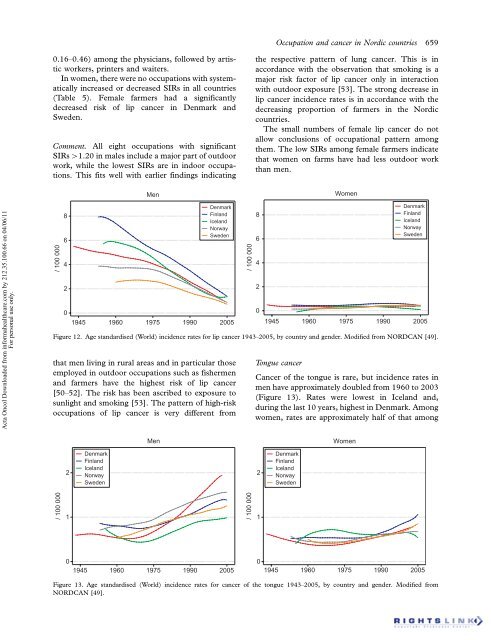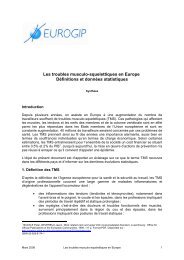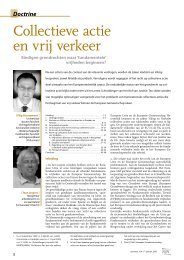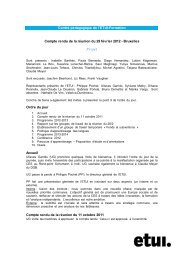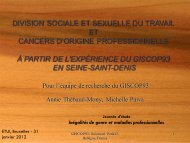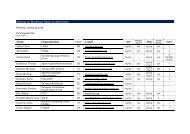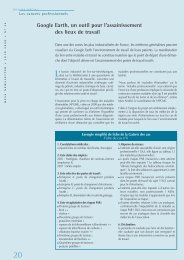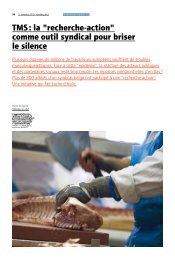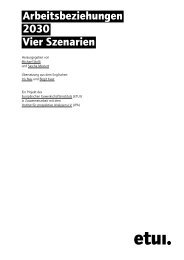Occupation and cancer - European Trade Union Institute (ETUI)
Occupation and cancer - European Trade Union Institute (ETUI)
Occupation and cancer - European Trade Union Institute (ETUI)
You also want an ePaper? Increase the reach of your titles
YUMPU automatically turns print PDFs into web optimized ePapers that Google loves.
Acta Oncol Downloaded from informahealthcare.com by 212.35.100.66 on 04/06/11<br />
For personal use only.<br />
0.16 0.46) among the physicians, followed by artistic<br />
workers, printers <strong>and</strong> waiters.<br />
In women, there were no occupations with systematically<br />
increased or decreased SIRs in all countries<br />
(Table 5). Female farmers had a significantly<br />
decreased risk of lip <strong>cancer</strong> in Denmark <strong>and</strong><br />
Sweden.<br />
Comment. All eight occupations with significant<br />
SIRs 1.20 in males include a major part of outdoor<br />
work, while the lowest SIRs are in indoor occupations.<br />
This fits well with earlier findings indicating<br />
/ 100 000<br />
8<br />
6<br />
4<br />
2<br />
0<br />
Men<br />
Denmark<br />
Finl<strong>and</strong><br />
Icel<strong>and</strong><br />
Norway<br />
Sweden<br />
1945 1960 1975 1990 2005<br />
that men living in rural areas <strong>and</strong> in particular those<br />
employed in outdoor occupations such as fishermen<br />
<strong>and</strong> farmers have the highest risk of lip <strong>cancer</strong><br />
[50 52]. The risk has been ascribed to exposure to<br />
sunlight <strong>and</strong> smoking [53]. The pattern of high-risk<br />
occupations of lip <strong>cancer</strong> is very different from<br />
/ 100 000<br />
the respective pattern of lung <strong>cancer</strong>. This is in<br />
accordance with the observation that smoking is a<br />
major risk factor of lip <strong>cancer</strong> only in interaction<br />
with outdoor exposure [53]. The strong decrease in<br />
lip <strong>cancer</strong> incidence rates is in accordance with the<br />
decreasing proportion of farmers in the Nordic<br />
countries.<br />
The small numbers of female lip <strong>cancer</strong> do not<br />
allow conclusions of occupational pattern among<br />
them. The low SIRs among female farmers indicate<br />
that women on farms have had less outdoor work<br />
than men.<br />
8<br />
6<br />
4<br />
2<br />
0<br />
Women<br />
Denmark<br />
Finl<strong>and</strong><br />
Icel<strong>and</strong><br />
Norway<br />
Sweden<br />
1945 1960 1975 1990 2005<br />
Figure 12. Age st<strong>and</strong>ardised (World) incidence rates for lip <strong>cancer</strong> 1943 2005, by country <strong>and</strong> gender. Modified from NORDCAN [49].<br />
/ 100 000<br />
2<br />
1<br />
Denmark<br />
Finl<strong>and</strong><br />
Icel<strong>and</strong><br />
Norway<br />
Sweden<br />
Men<br />
0<br />
1945 1960 1975 1990 2005<br />
/ 100 000<br />
Tongue <strong>cancer</strong><br />
Cancer of the tongue is rare, but incidence rates in<br />
men have approximately doubled from 1960 to 2003<br />
(Figure 13). Rates were lowest in Icel<strong>and</strong> <strong>and</strong>,<br />
during the last 10 years, highest in Denmark. Among<br />
women, rates are approximately half of that among<br />
2<br />
1<br />
<strong>Occupation</strong> <strong>and</strong> <strong>cancer</strong> in Nordic countries 659<br />
Denmark<br />
Finl<strong>and</strong><br />
Icel<strong>and</strong><br />
Norway<br />
Sweden<br />
Women<br />
0<br />
1945 1960 1975 1990 2005<br />
Figure 13. Age st<strong>and</strong>ardised (World) incidence rates for <strong>cancer</strong> of the tongue 1943 2005, by country <strong>and</strong> gender. Modified from<br />
NORDCAN [49].


